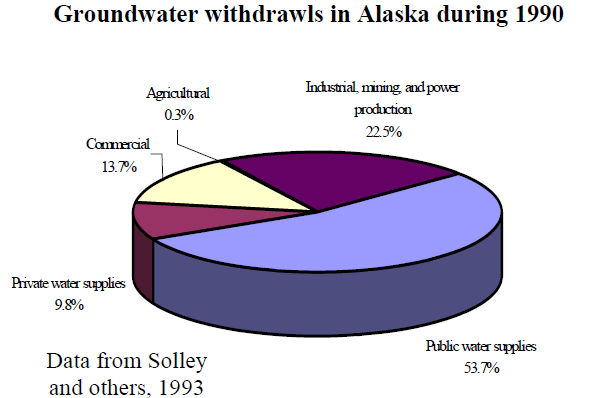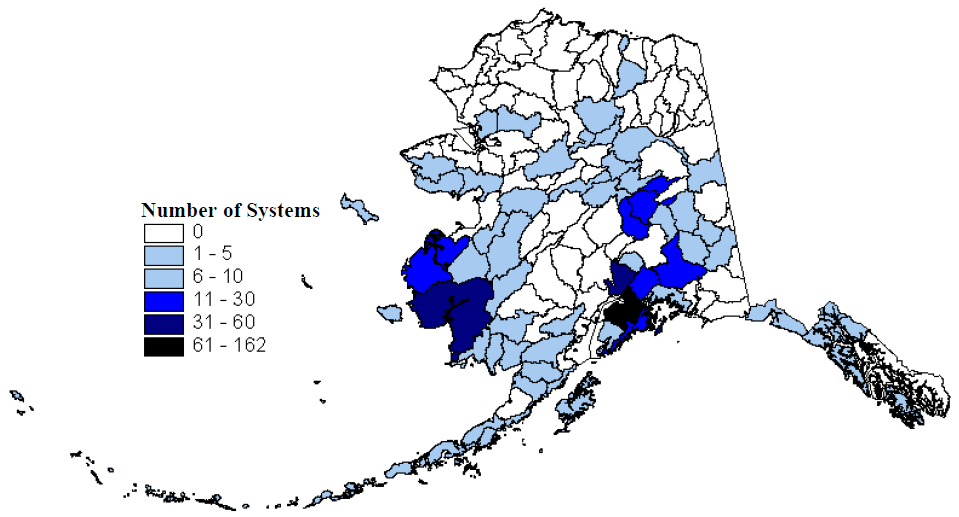Groundwater In Alaska
Groundwater Importance
 Alaska’s groundwater resources may be among the greatest in the nation. However, very few of Alaska’s aquifers have been studied (or even located) and limited water quality data is available.
Alaska’s groundwater resources may be among the greatest in the nation. However, very few of Alaska’s aquifers have been studied (or even located) and limited water quality data is available.
Alaska is sparsely populated by approximately 683,000 residents (approximately one resident per square mile). Urban development is concentrated in a few main population centers, with the majority of people living in southcentral Alaska. Nearly one-half of the state’s population lives in the Municipality of Anchorage. Other major population centers include Fairbanks in the state’s ‘interior’ and Juneau, the state capital, in southeast Alaska. Beyond these major population centers, communities tend to be small and generally not connected by roads.
 Groundwater is a source of drinking water for about 50 percent of Alaska’s population, and 90 percent of the state’s rural residents. Eighty-three percent of Alaska’s 1,602 public drinking water systems use a groundwater source. The total groundwater withdrawn for these public water systems represents only 37 percent of total freshwater used by public water systems. This is due to a small number of public water systems (e.g., Anchorage, Juneau, Ketchikan,) serving a large number of people from surface water sources.
Groundwater is a source of drinking water for about 50 percent of Alaska’s population, and 90 percent of the state’s rural residents. Eighty-three percent of Alaska’s 1,602 public drinking water systems use a groundwater source. The total groundwater withdrawn for these public water systems represents only 37 percent of total freshwater used by public water systems. This is due to a small number of public water systems (e.g., Anchorage, Juneau, Ketchikan,) serving a large number of people from surface water sources.
Ninety percent of the private drinking water supplies are groundwater.
Of the estimated 63 million gallons of fresh groundwater used in Alaska each day, over 50 percent (34mgd) is used for public water supplies. Approximately 23 percent (14mgd) is used for industrial, mining and power production; roughly 10 percent (6mgd) is used for domestic water. 14 percent (9mgd); Less than 1% (<1mgd) is used for agricultural activities (per USGS Ground Water Atlas of the United States 1997).
Groundwater Availability
Groundwater is available in most areas of Alaska, except where permafrost is very deep in the northern part of the state. Southcentral and interior Alaska have the greatest dependence on groundwater. Arctic, western, and southeastern Alaska make more frequent use of streams, rivers, lakes, and rainwater catch-ments. The largest groundwater withdrawals occur in the Anchorage, Fairbanks, Matanuska-Susitna Borough and Kenai Peninsula Boroughs.
Most of Alaska’s aquifers consist of unconsolidated materials derived from glaciers, rivers, and streams. Producing aquifers are typically unconfined (i.e., not protected by a layer of clay or silt), and the depth to groundwater ranges from a few feet to over 400 feet statewide.
Water Quality
Although water quality data is sparse, most of the state’s groundwater is suitable for domestic, agriculture, aquaculture, commercial, and industrial uses with moderate or minimal treatment. Naturally occurring iron, manganese, and arsenic are the most common treatment problems in groundwater systems. Storage and spills of fuel, along with wastewater disposal, primarily from onsite (septic) systems, are common threats to groundwater quality statewide. Additionally, a range of other activities either have potentially or actually affected groundwater quality (e.g., nonpoint pollution in urban areas, natural resource extraction activities in remote locations, and a wide range of potential point sources of pollution). Prevention of human exposure to contaminated groundwater is a main focus of the department’s program to remedy new and historic contamination, where leaking underground fuel tanks and other releases of oil and hazardous substances may have occurred. Efforts have been on-going since the late 1980s. Groundwater is known to be contaminated at 1,330 sites. Cleanup of groundwater is a lengthy process and is the biggest constraint to complete closure of contaminated sites. During the cleanup, primary efforts are to prevent use of the water for drinking and to monitor the status of contamination. Alaska’s contaminated sites include seven Superfund sites where cleanups have been under way for a number of years.
Cost of Contamination
The cost to clean up (remediate) contaminated groundwater can be staggering. Costs can run into millions depending on site conditions. Installing and operating groundwater remediation equipment and long-term groundwater monitoring are common expenses during remediation.
Efforts to Protect Groundwater
Protection of Alaska’s groundwater is largely accomplished through the regulation of contaminated sites, storage tanks, spill response, and specific waste disposal activities under state and federal programs at this time. The Alaska Department of Environmental Conservation (ADEC) manages several programs that contribute to the protection of groundwater, including ADEC’s Contaminated Sites, Storage Tank, Prevention & Emergency Response, Industry Preparedness & Pipeline, Solid Waste, Pesticides, Drinking Water, Wastewater, Watershed Development, Water Quality Protection, and Community Assistance & Information programs. US EPA’s Underground Injection Control Program, and a number of other important EPA programs, can also have a significant impact on groundwater quality in Alaska.
Division of Water
The Division of Water’s, Water Quality Programs are focused primarily on surface water pollution although they are also protective of groundwater since surface water quality can have an impact on groundwater quality through infiltration and percolation. Division activities which protect groundwater quality include the industrial construction , domestic, and on-site domestic wastewater permitting programs; water quality protection, stewardship, and restoration projects implemented by the Division or funded through the Alaska Clean Water Actions’s grant program; and development of waterbody recovery plans and Total Maximum Daily Loads (TMDLs) assessments.
The Division of Water’s Facilities Section funds through the Village Safe Water Program, grants and engineering assistance to small communities for water and sewer projects. The Section also through the Municipal Matching Grants and Loans program (MMG&L), administers the Alaska Clean Water Fund and the Alaska Drinking Water Fund which provide loans and engineering support for drinking water, wastewater (sewer), solid waste, and non-point source pollution projects, such as waterbody restoration and recovery. These loan programs are designed for cities, boroughs and qualified private utilities. In addition, MMG&L administers the Alaska Municipal Water, Sewerage, and Solid Waste Matching Grant Program, which primarily assist the larger communities and boroughs in the State.
Drinking Water Program
Currently there are 1,765 sources of drinking water that serve 1,602 public drinking water systems (PWS) in the State of Alaska. Of these PWS, 689 are classified as Community and Non-Transient, Non- Community and 913 are classified as Transient, Non-Community water systems. In July, 2004, the Drinking Water Program completed Phase I Source Water Assessments (SWAs) for each source of drinking water used by Alaska PWSs. Phase II is currently in process and assess all the new sources that became active after December 31st 2000.
The SWAs established drinking water protection areas and vulnerability assessments of the risk to PWS from existing and potential sources of contamination. They serve as a foundation or “stepping stone” to comprehensive management and protection of Alaska’s groundwater resources and have led to the development of a voluntary program for Alaska Drinking Water Protection which provides tools, resources and assistance to PWS owners and operators in developing individual or community-based Drinking Water Protection Plans (DWPP). A DWPP identifies protection activities directed at existing or potential contaminant risks using the SWAs, establishes a strategy for implementing protection activities, and sets up an implementation schedule.
The SWAs will also be a crucial tool that the State will use to comply with the new (EPA) Ground Water Rule, promulgated in November 22, 2006 and finalized January 8, 2007. This Rule gives the State the option to conduct hydrogeologic sensitivity assessments (HASs) to identify PWSs using groundwater sources that are sensitive to contamination. The basics for these HAS’s were completed as part of Alaska’s PWS SWAs vulnerability assessment.

 Indicates an external site.
Indicates an external site.